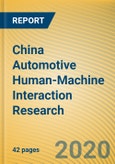Automotive HMI refers to the process of information exchange between humans and the car through interaction means such as voice, gesture, face, AR, holographic display and fingerprint recognition.
Over a decade of development, in-car voice interaction was installed to 28.7% of vehicles and even a higher share of new models on the market in the first half of 2019. Voice interaction is extending from infotainment (navigation, multimedia, etc.) to body control (windows, sunroof, lights, wipers, trunk, etc.) and life services (car-home connectivity, in-car shopping, etc.), and voice technology is getting through to infotainment protocols and in-car ecology.
Gesture recognition was first found in the BMW model in 2015 and has been successively available in China-made models such as the Traum SEEK 5, Chery 5X, Xpeng G3 Premium, etc. It is mainly used to control the display system in the car, such as music play, volume regulation, map zoom, etc., as a supplementary interactive mode in a quiet environment.
Face recognition, unveiled in China in 2018, has been seen in Leapmotor S01, Chery’s EXEED TX, WEY VV6, WM Motor’s EX5, Geely Xing Yue and other models, showing a rosy prospect. Face recognition is mostly for personalized settings (seat position, ambient light preference, rearview mirror position, music recommendation, etc.) and driver status detection. EXEED TX supports to buy movie tickets by face scanning and heads toward face payment.
In addition, new interactive modes like window interaction (WM Motor's EX5), body interaction (BAIC BJEV's LITE), vein recognition (Leapmotor SO1), fingerprint recognition (Hyundai’s New SantaFe), and AR navigation (Roewe Marvel X) have been available onto production vehicles.
Foreign automotive HMI systems include BMW iDrive, Mercedes-Benz MBUX, Audi MMI, Ford SYNC +, etc. Among them, BMW iDrive has iterated to 7.0, with 6 interaction modes covering button, knob, touch, gesture, voice and cellphone. BMW iDrive is the first system in the world that adds gesture interaction, which can control phone calls, music playback, volume, map, menu, etc.
Chinese automotive HMI systems mainly embrace Geely GKUI, BYD DiLink, GAC ADiGO, SAIC Banma, Chery Lion, NextEV NIO OS, Xpeng Xmart OS, etc. Among them, Geely GKUI has been upgraded to GKUI2019 with 8 interaction modes via button, knob, touch, voice, cellphone, HUD, face recognition, and smartwatch, where unique features are watch interaction (mainly ideal for remote car control and vehicle information inquiry like mobile phone interaction) and face recognition (FACE ID personalized settings).
In short, automotive HMI has entered the multi-modal (voice, gesture, face, etc.) interaction stage and is heading toward functional enrichment and multi-modal fusion. Moreover, HMI will transfer from in-vehicle interaction to multi-scenario interaction, from ""passive interaction"" to ""active interaction"".
China Automotive Human-Machine Interaction (HMI) Research Report 2020 highlights the followings:
- HMI (definition and development history), automotive HMI (design, development course, etc.)
- Automotive HMI modes (voice interaction, face recognition, gesture recognition, and display inside and outside the vehicle)
- Development history and modes of HMI systems of automakers at home and abroad, such as BMW iDrive, Mercedes-Benz MBUX, Audi MMI, Geely GKUI, SAIC Banma SmartDrive, Chery Lion, BYD DiLink, GAC ADiGO, NextEV NIO OS, etc.
- Development trends of automotive HMI.
This product will be delivered within 3-5 business days.
Table of Contents
Companies Mentioned
- Audi MMI
- BMW iDrive7.0
- BYD DiLink
- Chery Lion
- GAC ADiGO
- Geely GKUI
- Mercedes-Benz MBUX
- NextEV NIO OS
- SAIC Banma
Methodology

LOADING...







